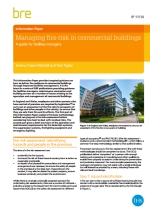Managing fire risk in commercial buildings: A guide for facilities managers
BRE (Building Research Establishment) is an independent, research-based consultancy, testing and training organisation, operating in the built environment and associated industries.
Managing fire risk in commercial buildings: A guide for facilities managers (IP 11/14) was published by BRE on 23 September 2014. It was written by Jeremy Fraser-Mitchell and Tom Taylor. It is one of a number of BRE publications offering guidance for facilities managers, maintenance contractors and building owners about the operation and management of commercial buildings.
In England and Wales, employers and other people who have control of premises must carry out an assessment of the fire risks to occupants of buildings and other people in the vicinity, to ensure that they are safe from fire and its effects. IP 11/14 provides guidance about how improved facilities management can help deliver fire resilience in commercial buildings.
The first part of the 8-page Information Paper explains how to carry out a fire risk assessment and how best to deal with residual risks. The second part gives an overview of operational and maintenance requirements for fire detection systems, fire suppression systems, firefighting equipment and emergency lighting.
The contents of the Information Paper are:
- Fire risk assessment: identifying hazards and people in the premises.
- Fire risk management: coping with residual risks.
- Planning, recording, instruction and training.
- Fire protection equipment and facilities.
- Conclusions.
- References.
[edit] Related articles on Designing Buildings Wik
- Automatic fire detection and alarm systems, an introductory guide to components and systems BR 510.
- Automatic fire sprinkler systems: A good practice guide.
- BRE articles on Designing Buildings Wiki.
- BRE Buzz articles on Designing Buildings Wiki.
- BRE Buzz.
- Building Research Establishment.
- External fire spread, Supplementary guidance to BR 187 incorporating probabilistic and time-based approaches.
- External fire spread: building separation and boundary distances (BR 187).
- Fire performance of external thermal insulation for walls of multistorey buildings, third edition (BR 135).
- Fire risk in high-rise and super high-rise buildings DG 533.
- Fire safety certification from CIOB.
- Fire suppression.
- Managing risks in existing buildings: An overview of UK risk-based legislation for commercial and industrial premises (FB 86).
- Risk assessment under The Regulatory Reform (Fire Safety) Order 2005.
- The Regulatory Reform (Fire Safety) Order 2005.
- The role of codes, standards and approvals in delivering fire safety.
- Understanding the factors affecting flashover of a fire in modern buildings.
- Visual alarm devices - their effectiveness in warning of fire.
Featured articles and news
Homes England creates largest housing-led site in the North
Successful, 34 hectare land acquisition with the residential allocation now completed.
Scottish apprenticeship training proposals
General support although better accountability and transparency is sought.
The history of building regulations
A story of belated action in response to crisis.
Moisture, fire safety and emerging trends in living walls
How wet is your wall?
Current policy explained and newly published consultation by the UK and Welsh Governments.
British architecture 1919–39. Book review.
Conservation of listed prefabs in Moseley.
Energy industry calls for urgent reform.
Heritage staff wellbeing at work survey.
A five minute introduction.
50th Golden anniversary ECA Edmundson apprentice award
Showcasing the very best electrotechnical and engineering services for half a century.
Welsh government consults on HRBs and reg changes
Seeking feedback on a new regulatory regime and a broad range of issues.
CIOB Client Guide (2nd edition) March 2025
Free download covering statutory dutyholder roles under the Building Safety Act and much more.
Minister quizzed, as responsibility transfers to MHCLG and BSR publishes new building control guidance.
UK environmental regulations reform 2025
Amid wider new approaches to ensure regulators and regulation support growth.
BSRIA Statutory Compliance Inspection Checklist
BG80/2025 now significantly updated to include requirements related to important changes in legislation.
























